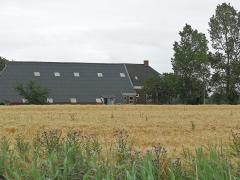Exploring global changes in nitrogen and phosphorus cycles in agriculture induced by livestock production over the 1900–2050 period
Global nutrient surpluses will continue to increase in the next fifty years. This will lead to larger amounts of nutrients in soil and surface waters, disrupting ecosystems and harming biodiversity.
Human alteration to nutrient cycles
This study shows that crop and livestock production systems are the largest cause of human alteration to global nitrogen and phosphorus cycles. The demand for animal feed produced from different crops and by-products of the food industry has rapidly increased over the past century. At the same time there has been a gradual, agricultural intensification, which has influenced the composition of livestock diets. At present, about 30% of global arable land is used for producing animal feed, probably also involving similar use of fertilizer.
From balanced nutrient budgets to surpluses
Our inventory of nitrogen and phosphorous budgets in crop and livestock production systems shows that, in the beginning of the twentieth century, nutrient budgets were either balanced or surpluses were small. Between 1900 and 1950, global soil nitrogen surplus almost doubled and soil phosphorous surplus increased by a factor of eight. Between 1950 and 2000, global surpluses increased further. Most of the nitrogen surpluses stem from environmental losses via leaching to groundwater, ammonia volatilisation or denitrification; surplus phosphorus is lost in runoff or accumulates as residual phosphorus in soil.
Surpluses will increase
The International Assessment of Agricultural Knowledge, Science and Technology for Development (IAASTD) scenario portrays a world with a further increasing global crop and livestock production. Despite rapidly increasing recovery (withdrawal in harvested products as a fraction of inputs) in crop and livestock production, global nutrient surpluses continue to increase, and Africaand Latin Americawill also develop a surplus.
Nutrient flow reduction options
Alternative management of livestock production systems shows that combinations of intensification, better integration of animal manure in crop production, and matching nitrogen and phosphorous supply to meet livestock requirements may effectively reduce nutrient flows. A shift in human diets, with poultry or pork replacing beef, may reduce nutrient flows in countries with intensive ruminant production systems.
Authors
Specifications
- Publication title
- Exploring global changes in nitrogen and phosphorus cycles in agriculture induced by livestock production over the 1900–2050 period
- Publication date
- 6 June 2011
- Publication type
- Publication
- Magazine
- Proceedings of the National Academy of Sciences of the United States of America (PNAS)
- Product number
- 439




